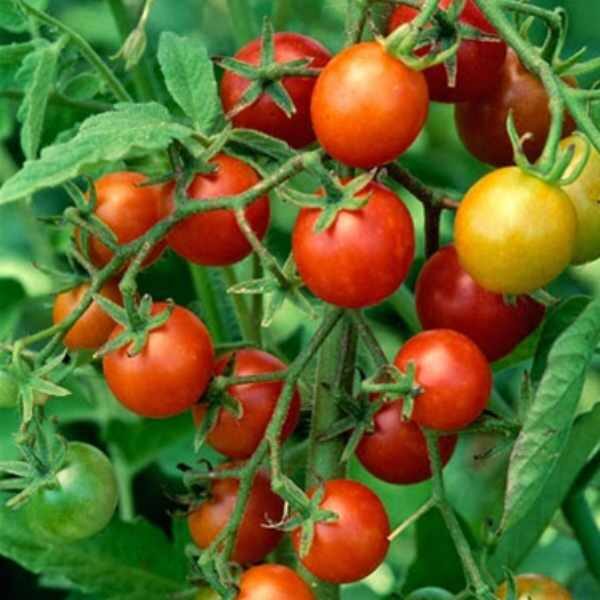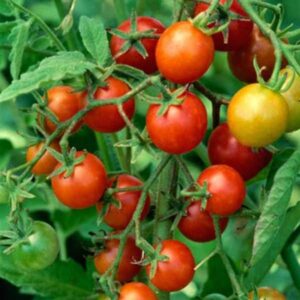Tomato Cherry Fox
$4.95
Lycopersicon Esculentum
- Seed Count 40
- Strong Producer
- Annual
In stock
Description
Tomato Cherry Fox is a delightful addition to any garden as these seeds promise to yield fruit that is not only vibrant and robust but also full of flavour, making them a standout option for your vegetable patch. With a delightful balance of sweetness and acidity, these 3cm cherry tomatoes can elevate any dish, from fresh salads to gourmet pizzas, showcasing their versatility in the kitchen.
What sets Tomato Cherry Fox apart is its hardy nature and resilience. with the ability to thrive in a range of environments, making them suitable for both suburban backyards and small urban spaces. Whether you’re planting in rich soil or a container on a balcony, Cherry Fox tomatoes adapt well, making them an excellent choice for those who may be limited by space or soil quality.
Another noteworthy aspect is their disease resistance. They are known to withstand common tomato ailments, reducing the need for chemical interventions and allowing gardeners to cultivate their plants more naturally. This hardiness lends well to the sustainability efforts many gardeners are keen to adopt today, as it aligns with growing eco-consciousness and a desire to limit chemical use in food production.
Indeterminate, climbing variety. Requires staking.
Related Articles
| Method: Raise seedlings | Soil Temp: 16°C - 35°C |
| Cool Mountain: Oct - Dec | Position: Full sun |
| Arid: Aug - Mar | Row Spacing: 50 cm |
| Temperate: Aug - Dec | Planting Depth: 3mm |
| Sub Tropical: Aug - Jan | Harvest: 80 Days |
| Tropical: May - Jul | Plant Height: 1m |
Basics
- Capsicum (sweet/bell Capsicum) thrives in warm, sunny gardens.
- Plant them in a spot with full sun (6+ hours) and rich, well-drained soil.
- Prepare the bed by removing weeds and digging in plenty of compost or aged manure.
- Use mulch around plants to retain moisture and suppress weeds.
Seed Trays vs Direct Sowing
Seedling Trays:
- Raise seeds in pots or trays filled with seedling mix, keeping them warm (16-35°C) and moist.
- This protected start speeds germination and gives plants a head start on weeds and weather.
- You’ll use fewer seeds and get sturdy seedlings for an earlier crop.
- The downside is extra effort and cost (pots, mix, heat source) and you must harden-off seedlings before planting out.
Direct Sowing:
- Plant seeds 3mm deep in the garden soil 50cm between plants, 60–100cm once it’s warm and frost-free.
- Direct sowing is simpler and cheaper (no trays or special mix), but germination is slower and more vulnerable to cold, pests or heavy rain.
- Capsicum seeds can take 1–3 weeks to sprout at 16–35°C.
- Ensure the soil stays evenly moist (not waterlogged) during this time.
In short: use trays if you want the best germination and an early start; sow direct if you prefer simplicity and have already warm conditions.
Planting and General Care
Timing & Spacing:
- Plant or transplant capsicum after all danger of frost has passed.
- In tropical/subtropical areas, Capsicums can even fruit year-round, but in cooler zones treat them as an annual summer crop.
Soil:
- Use well-drained, fertile soil rich in organic matter.
- Work in compost or aged manure before planting.
- Capsicums prefer a slightly acidic to neutral pH (~6.0–7.0).
- In pots, use at least ~40L per plant.
Watering:
- Water deeply and regularly, so the soil stays evenly moist.
- Check soil moisture by pushing a finger 4–5cm down; water when that layer is just dry.
- Water in the early morning or late afternoon to minimize stress.
- Avoid wetting the leaves, which can encourage fungal disease.
- Mulch around plants to keep roots cool and reduce evaporation.
Fertilising:
- If the soil was well-prepared, you may need little extra feed.
- Otherwise, apply a balanced (e.g. 10-10-10 NPK) slow-release fertilizer at planting.
- Once flowers and fruit start, give a liquid tomato or vegetable fertilizer every few weeks according to label directions.
- This supports heavy fruiting. Avoid excessive nitrogen late in the season, as it can reduce fruit set.
Staking & Pruning:
- Capsicum plants can get top-heavy with fruit. Stake or cage them when planting.
- A simple sturdy stake beside each plant works – gently tie the main stem (e.g. with soft string) as it grows.
- This prevents wind damage and keeps fruit off the ground.
- Remove any low or damaged leaves to improve air flow.
- Many gardeners also pinch out a few early flower buds when plants are young – this encourages stronger vegetative growth and heavier later yields.
- Overall, little pruning is needed beyond this.
Pest & Disease Management:
- Monitor plants for pests like aphids, caterpillars, slugs/snails, and chilli thrip.
- Hand-pick pests or use organic sprays if needed.
- Practice good hygiene: remove weeds and crop debris.
- Rotate capsicum/solanaceous crops to a different spot each year to reduce disease pressure.
- Common diseases include blossom-end rot (from inconsistent watering or low calcium) and fungal spots.
- Regular watering and mulch help prevent blossom-end rot.
- Crop rotation and not overcrowding plants also reduce problems.
Chilli Thrips: What They Are & How to Deal With Them
- Chilli thrips (Scirtothrips dorsalis) are tiny, slender insects that can cause big problems in home veggie patches—especially for capsicum, chilli, eggplant, and tomato plants.
- You might not see them easily (they’re less than 2mm long!), but the damage is easy to spot as leaves curl or look bronzed and scarred, buds drop off, and fruit can become deformed or scarred.
- These pests feed by piercing plant tissue and sucking out the juices, which leads to silvery or brown patches on leaves and distorted growth.
- They tend to hang out on the newest growth, flower buds, or the undersides of leaves—so grab a magnifying glass and check these spots first if your plants are looking stressed.
What You Can Do:
Prevention is key:
- Start clean – Avoid bringing in infested seedlings or cuttings.
- Attract beneficial bugs like lady beetles, lacewings, and predatory mites—they’ll help keep thrip numbers down.
- Plant flowers like alyssum, marigold, or dill nearby to draw in the good guys.
If they show up:
- Prune affected areas early to stop the spread.
- Hose them off gently with water to dislodge thrips from foliage.
- Apply insecticidal soap or horticultural oil, covering all leaf surfaces, especially underneath. Repeat weekly as needed.
- Rotate your crops each year to disrupt their lifecycle.
Tip: Thrips love hot, dry conditions—so keep your plants well-watered and mulched to reduce stress and deter infestations.
Companion Planting with Capsicum
Good companions:
- Herbs & Flowers: Basil, dill, parsley, coriander, chamomile and other aromatic herbs as they attract beneficial insects and may repel aphids or whiteflies. Garlic, onions, chives as their strong scent deters many pests. Marigolds, nasturtiums, borage, lavender as these flowers lure pollinators and trap pests (marigolds are famous for nematode control).
- Vegetables: Carrots, lettuce, spinach as they occupy shallow roots and don’t compete much with Capsicums. These can provide light ground cover under Capsicum plants. Tomatoes are sometimes planted alongside Capsicums (both like similar conditions) but be aware they share some pests/diseases so give them space and rotate beds regularly.
- Fruits: Strawberries and cucumbers have been noted as decent neighbours (shallow roots and shade from cucumber leaves can protect Capsicums).
Bad Companions
- Other heavy feeders or close relatives.
- Do not grow next to eggplants, potatoes or tomatoes in succession, as they share pests/diseases.
- Stay away from beans/peas and plants like fennel or dill, which can inhibit Capsicum growth.
- Squash and pumpkins (deep-rooted cucurbits) can out-compete Capsicums for nutrients.
- In short, pair Capsicums with light-feeders and pest-deterring plants, and keep them apart from other nightshades and big gourds.
Seed Saving
Saving your own Capsicum seeds is easy if you follow a few simple steps:
Select plants:
- Pick the healthiest plants with strong, typical fruit.
- If growing multiple types, isolate them (e.g. bag flowers or keep 20m+ apart) to prevent cross-pollination.
Harvest ripe fruits:
- Wait until Capsicums are fully ripe on the plant which is usually when they’ve changed to their final colour and just start to soften or wrinkle.
- Allowing fruits to over ripen a little ensures the seeds are mature.
Extract seeds:
- Cut the Capsicum in half and scoop or twist out the central core.
- Scrape out the seeds and remove as much of the inner flesh and pith as possible.
- Rinse the seeds in clean water to wash off any remaining pulp which helps them dry cleanly.
Dry seeds:
- Spread the seeds in a single layer on paper towels or a clean plate in a dry, shaded place.
- Let them dry completely over several days.
- They’re ready when you can crunch a seed in your fingers and it snaps rather than bends.
- Moisture is the enemy of seed storage, so make sure they feel fully dry.
Store seeds:
- Transfer the dried seeds to a paper envelope or small jar with a tight lid.
- Label with variety and date.
- Store in a cool, dark, dry spot (a refrigerator works well).
- Properly stored Capsicum seeds remain viable for about 3–4 years, so you’ll have plants for many seasons.
Climate and Growing Conditions
Best Growing Seasons:
- In most regions of Australia, tomatoes generally thrive when planted from September to November (spring) and will produce through summer until April, depending on local climate.
- See individual climate zone information on the product description tab.
Ideal Temperature
- Tomatoes prefer daytime temperatures between 20-30°C.
- Nighttime temperatures should ideally be above 10°C to promote good fruit set.
Site Selection
Sunlight:
- Choose a location that receives at least 6-8 hours of full sunlight daily.
- Tomatoes grow best in warm, sunny spots.
Soil Type:
- Well-draining soil is crucial as tomatoes do not tolerate waterlogged conditions.
- Sandy loam or loamy soil enriched with organic material is ideal.
Soil Preparation
Soil Testing:
- Before planting, conduct a soil test to determine pH and nutrient levels.
Amending Soil:
- Amend the soil with compost or well-rotted manure.
- Aim for a pH level between 6.0 and 6.8 for optimal growth.
Loosening Soil:
- Work the soil to a depth of at least 30 cm and remove any debris or rocks.
Planting Instructions
Starting Seeds:
- Start seeds indoors 6-8 weeks before the last expected frost date or plant in situ in mid spring.
Transplanting:
- Harden seedlings by gradually exposing them to outdoor conditions for about a week before planting.
Spacing:
- Plant seedlings 60-90 cm apart to ensure adequate airflow and reduce the risk of diseases.
Watering Practices
Frequency:
- Water deeply and regularly, especially during dry periods. Aim for about 2-3 cm of water per week.
Method:
- Use a soaker hose or drip irrigation to avoid wetting the foliage and minimize the risk of fungal diseases.
Signs of Water Stress:
- Monitor for wilting leaves (indicating too little water) or cracking fruit (indicating too much water).
Nutrient Management
Fertilisation:
- Use a balanced fertiliser (with equal N-P-K values) at planting.
- As plants grow and start flowering, switch to a fertiliser higher in phosphorus (the middle number of N-P-K) to promote fruiting.
Organic Options:
- Consider organic fertilizers like fish emulsion or seaweed extract.
Growing Indeterminate vs. Determinate Tomatoes
Tomatoes come in two main growth habits—indeterminate and determinate—and understanding the difference is key to growing them successfully.
Indeterminate Tomatoes
Growth Habit:
- These tomatoes grow like wild vines, stretching taller and producing fruit all season until frost kills them.
- Think of them as the marathon runners of the tomato world.
What They Need:
- Strong Support: Indeterminates need tall, sturdy stakes, cages, or trellises about 2m tall.
- Letting them sprawl invites disease and wasted space.
- Pruning: Remove suckers (those little shoots between stems and branches) to focus energy on fruit production.
- A well pruned plant yields better air circulation and bigger tomatoes.
- Space: Give them room—plant at least 2–3 feet apart so they don’t turn into a tangled jungle.
Best For: Gardeners who want a long harvest and don’t mind a little maintenance
Determinate Tomatoes
Growth Habit:
- These grow to a set size of around 1m, produce all their fruit in a short window, and then call it quits.
What They Need:
- Moderate Support: A short cage or stake is usually enough—they’re bushier but not as wild as indeterminates.
- Less Pruning: Leave the suckers alone.
- These plants are programmed to stay compact, so over pruning can reduce yield.
- Space: Plant 50cm apart. They’re good for small gardens or containers.
Best For: Busy gardeners, container growers, or those who want a big harvest all at once.
The Bottom Line
Indeterminates = Keep growing, keep producing, need training.
Determinates = Grow to size, fruit all at once, low maintenance.
Pest and Disease Management
Common Pests:
- Aphids: Small, green bugs that suck sap. Control them with insecticidal soap.
- Whiteflies: Small, flying pests; use yellow sticky traps to catch them.
- Tomato Hornworms: Large caterpillars that can defoliate plants.
- Handpick them off or use Dipel (Bacillus thuringiensis).
Diseases:
- Blight: Watch for yellowing leaves and brown spots. Ensure good air circulation and avoid overhead watering.
- Powdery Mildew: Look for a white powdery substance on leaves. Improve air circulation and treat with fungicides if necessary.
Pruning and Supporting Plants
Pruning:
- Regularly remove suckers (small shoots between the main stem and branches) to encourage better air circulation and direct energy to fruit production.
Support:
- Use cages or stakes to support indeterminate varieties, which continue to grow throughout the season, preventing fruits from touching the ground.
Harvesting and Storage
Timing:
- Harvest tomatoes when they’re fully coloured and slightly firm.
- Most tomatoes will ripen on the vine; pick them just before full ripeness in very hot conditions.
Storage:
- Store harvested tomatoes at room temperature, away from sunlight, for optimal flavour and texture.
- Avoid refrigerating as it can change the texture and flavour.
Blossom End Rot
Overview:
- Blossom end rot is a common physiological disorder that affects tomatoes and other fruits, characterized by a dark, sunken spot on the blossom end of the fruit.
- It is not a disease caused by pathogens but rather a symptom of nutrient imbalance and environmental stress.
Causes:
- Calcium Deficiency: The primary cause of blossom end rot is a lack of calcium in the developing fruit. Calcium is essential for cell wall structure and growth.
- Inconsistent Watering: Fluctuations in soil moisture can inhibit the plant’s ability to uptake calcium. Periods of drought followed by heavy watering can exacerbate the problem.
- High Nitrogen Levels: Excessive nitrogen fertilization can promote leafy growth at the expense of fruit development, leading to calcium deficiency in the fruit.
- Soil pH and Conditions: Soil with low pH or poor drainage can affect calcium availability in the soil.
Symptoms:
- Dark, sunken spots usually appear at the blossom end (the bottom) of the fruit.
- The affected area often becomes soft, and the fruit may rot if not harvested promptly.
- Symptoms tend to occur on the first few fruits developed on the plant, particularly during the early fruiting stage.
Prevention
Soil Testing:
- Conduct a soil test to determine pH and nutrient levels before planting.
- Aim for a pH between 6.0 and 6.8.
Consistent Watering:
- Maintain even soil moisture by watering regularly, especially during dry spells.
- A deep watering once a week is better than shallow, frequent watering.
Balanced Fertilization:
- Use a balanced fertilizer, being cautious not to over-fertilize with nitrogen.
- A fertilizer high in phosphorus (the middle number in N-P-K) can help promote healthy fruit development.
- Consider also using calcium supplements like gypsum or lime if needed.
Mulching:
- Mulch around the base of the plants with organic material to help retain moisture and stabilize soil temperature.
Remove Affected Fruits:
- While you can’t save the already affected fruits, removing them can help the plant redirect energy toward developing healthy fruit.
Postage Charge
Orders under $30 attract a $4.95 shipping charge. Orders $30 and above have free shipping.
Order Times
Seed orders are normally dispatched within three business days. You will receive an email when seeds are mailed out.
Postage Days
Seeds are mailed out Monday to Friday at 1pm. Except for the Friday of long weekends.
Postage Times
WA 2-3 Days: SA,NT 3-5 Days: NSW, ACT, QLD, VIC: 5-7 Days
Carrier
We use Australia Post Letter Postage for the majority of orders
Not only are our seeds packed in recycled paper envelopes, we keep the theme going when we post out website orders. To protect your seeds from moisture and the letter box munchers (snails), we use a very special plastic free material made from plants. They are then put into recycled mailing envelopes. Green all the way 💚🌿












1 review for Tomato Cherry Fox